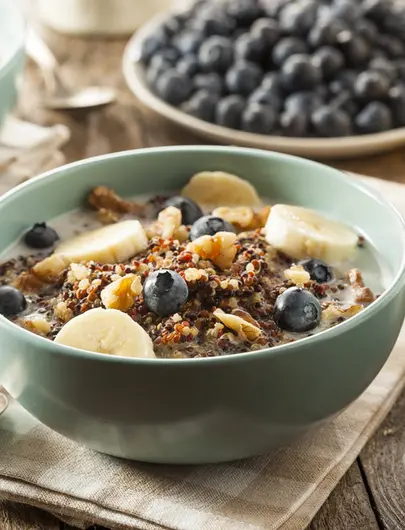Back
Every cell in our body needs protein; In fact following water, protein comprises the largest amount of our body weight. A ‘macronutrient’, meaning a nutrient we need in large amounts (along with carbs, fat and water), there’s much more that protein does other than helping keep your blood sugar stable and appetite under control…
Vital for life, we need protein for growth and development, energy production, and the manufacturing of:
- Hormones , which are in charge of the processes that go on in our body, regulating cell or organ activity. Insulin for example is a hormone produced in, and secreted from the pancreas in response to a rise in blood glucose (sugar); Insulin reduces our blood glucose levels by transporting glucose into our cells, where it becomes stored energy or ‘glycogen’.
- Enzymes , substances in our body that ‘catalyse’ or speed up the rate of a chemical reaction. Digestive enzymes for instance break down the protein, fat and carbohydrate components of the food we’ve eaten as it goes down the digestive tract, so that it’s digested and absorbed sufficiently.
- Antibodies – An integral part of our immune system, antibodies are produced to fight potentially harmful foreign substances (‘antigens’), such as bacteria, viruses or toxic chemicals.
- Tissues – Protein is integral to the structure of our muscle tissue (which explains its inclusion in sport supplements), as well as our glands, ligaments and tendons. Our skin, hair and nails also all contain protein.
So how much protein do I need and how should I be eating it?
This depends on the stage of life stage you’re at, the average amount of energy you expend and your health status. Your typical healthy adult should aim to eat about 0.8-1.2 g of protein/kg of body weight daily. If you’re reasonably active (a lifestyle habit I’m condoning!), 1-1.2g of protein/kg of body weight is ideal. Protein requirements are higher in life stages such as pregnancy, and for individuals like endurance athletes*.
Obviously most of us won’t sit and calculate the exact amount of protein we’re eating each day, but what I do is try have a protein-portion that’s the size and thickness of my palm with main meals; Seeing a piece of salmon this size gives you about 24g protein, and the equivalent amount of chicken +- 30g protein, eyeballing your protein-portions can help you meet your daily requirements.
The source of your protein is also worth thinking about…
Whether it’s from meat, fish or tofu, once we eat protein, it’s broken down into amino acids – The building blocks of protein, these work to manufacture protein-based substances within the body; Some amino acids can be synthesised by the body, but others are essential, meaning we need to obtain them from food.
Complete protein - found in animal products like meat, poultry, fish and eggs -contains every essential amino acid. Then there’s incomplete protein; Found in plant-based food, it contains some but not all of the essential amino acids; So if you’re a vegetarian or vegan, the trick is to combine two different plant-based protein food sources (like beans and brown rice), which in turn gives you a complete protein.
“I can’t think of many high-protein breakfast ideas. Any suggestions?”
Unless you have eggs or some other kind of animal protein for breakfast (I for one can’t stomach a piece of fish first thing in the morning), it’s hard to find breakkie options with substantial protein; This is where a good quality protein powder comes in handy - Add a scoop to a smoothie, or if you’d like some chew, give this protein-packed, Balanced Brekkie Bowl a go; Yoghurt isn’t typically high in protein, but the addition of protein powder bumps up the protein content and staying power of this dish:
Recipe: Balanced Brekkie Bowl
Ingredients
- 2 TBS traditional rolled oats (or if you’re gluten free, sub with GF cereal/muesli)
- ½ Cup full fat Greek yoghurt (or coconut milk yoghurt)
- 1 scoop Protein Supplies Australia’s Vanilla PeaPro (Raw Pea Protein)
- handful fresh or frozen berries
- 2 tsp raw, chopped almonds
- 2 tsp almond butter
Method
- Place oats in a small bowl/teacup/wine glass
- Top with yoghurt and stir protein powder through the yoghurt
3.Throw berries on top and add the nuts and nut butter for some extra crunch and creaminess. Delicious!
Protein Supplies Australia Vanilla PeaPro (Raw Pea Protein):
- Rich in amino acids & Low G.I
- High alkalinity & high bioavailability
- Vegetable based protein with no added sugar
- Dairy free, gluten free & cholesterol free
- GMO free & vegan safe
- High digestibility
- Kosher & halal approved
*Hechtman L 2012, ‘Chapter 13: The Urinary and Renal System’ in Clinical Naturopathic Medicine, ed L Hechtman, Elsevier Australia, Sydney, p. 699.

